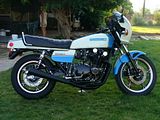Basically isn't the block a big heat sink? and the iron sleeves the processor so to speak. I know they are a tight fit but no matter what there is still a small air gap in places.
so if you removed the sleeves when you did a rebuild and coated them in some of this paste stuff then put them back in wouldn't that help dissipate the heat to the block better? which would give you better cooling?
here is some basic info on the stuff
http://en.wikipedia.org/wiki/Thermal_grease
And here is a mds sheet of one of the brands,
http://www.arcticsilver.com/PDF/ceramique_msds.pdf
Aluminum Oxide
Boron Nitride
Zinc Oxide
Proprietary Oil Blend Non-hazardous
It has a flash point of 600 degrees F, so that shouldn't be a problem.
The only other thing think I can think of is maybe some sort of oxidation would happen and that would either jeopardize the heat dissipation or lock the sleeves into the block.
I was also thinking if I used one of the metal based pastes you could use it in place of anti seize (which I have heard hinders heat displacement between spark plug and head) which would help displace the heat from the plug to the head.
Anyone got any ideas or anything to add. Hearing from some Mechanical engineers would be nice.
.png)


Comment